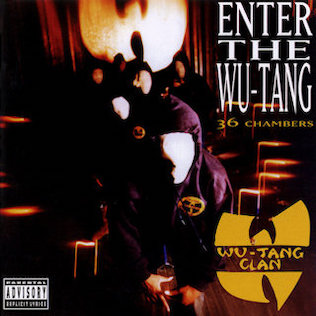
Wu-Tang Clan – 36 Chambers
Enter the Wu-Tang (36 Chambers): When Nine MCs Cast a Shadow Over Hip-Hop That Still Looms
Like a kung-fu master emerging from a misty Shaolin temple to unleash devastating techniques, Wu-Tang Clan’s debut album didn’t just enter hip-hop – it kicked down the door, threw everyone’s expensive leather jackets out the window, and redefined what raw could sound like in rap music.
The RZA, hip-hop’s own mad scientist, crafted a soundscape that makes Dr. Frankenstein’s experiments look like a kid’s chemistry set. Dusty soul samples clash with martial arts movie snippets while drums hit harder than Kareem Abdul-Jabbar in “Game of Death.” Every beat feels like it was assembled in a grimy Staten Island basement with equipment held together by duct tape and pure conviction. And somehow, it’s perfect.
When Method Man growls through “M.E.T.H.O.D. Man” like a gravelly-voiced demon who just gargled with battery acid, you realize this isn’t your uncle’s hip-hop collection of “Rapper’s Delight” and “The Message.” This is something grittier, something that would make your parents not just question your music taste but possibly your life choices.
The album plays like a cipher where each MC is trying to outdo the last, creating possibly the greatest posse cut collection in hip-hop history. “Protect Ya Neck” feels less like a song and more like watching eight ninjas perform increasingly impossible moves, each verse leaving you wondering “How are they gonna top THAT?” And then they do.
Ghostface Killah and Raekwon trade bars on “Can It Be All So Simple” like they’re playing verbal chess while everyone else is stuck on checkers. ODB (rest in peace) crashes through tracks like a hurricane in a china shop, his unhinged energy providing the perfect chaotic counterpoint to GZA’s surgical precision.
The production value might sound like it was recorded in a bunker during an apocalypse, but that’s exactly what makes it timeless. While other albums from ’93 were trying to sound clean and radio-ready, 36 Chambers embraced its muddy mix like battle scars. The result? It sounds as grimy and authentic in 2024 as it did when it dropped.
Every track is quotable to the point where you could probably write a graduate thesis just breaking down the metaphors in “C.R.E.A.M.” The way the group weaves together street knowledge, Five Percenter philosophy, and pop culture references makes Shakespeare look like he was writing nursery rhymes.
Let’s be real – this album hits harder than a sock full of quarters. It’s the kind of record that makes you want to wear Timbs in the middle of summer and practice kung-fu moves in your bedroom mirror. Twenty-plus years later, “36 Chambers” still makes most modern rap albums sound softer than a Care Bear convention.
For the uninitiated, this album might seem as accessible as a trigonometry textbook written in Sanskrit. But that’s the beauty of it – Wu-Tang wasn’t trying to hold anyone’s hand. They created their own universe with its own rules, slang, and mythology, and simply invited us to catch up.
Rating: 6 out of 5 Shaolin Swords 🗡️
Essential Tracks: Who are we kidding? The whole album is essential. Trying to pick standout tracks on “36 Chambers” is like trying to pick your favorite child – theoretically possible but spiritually wrong.
Final Thought: If this album were a kung-fu move, it would be the one that kills you, brings you back to life, and then makes you its disciple. Wu-Tang forever, indeed.